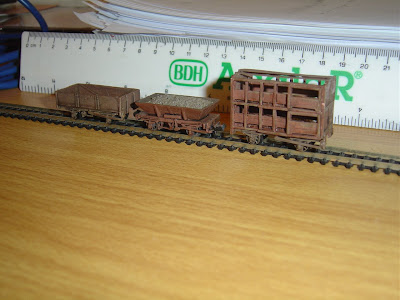Courtesy of Kiwibonds we have this mornings post. As with any post the views here are not the views of the blogs owners unless they coincide with the views of the blogs owner in which case they are said views. Again thank you for your attention.
Did Trackside 120 move the scale to the next level or deflate the hopes of a new generation?
Pate Eade’s Trackside 120 kits broke new ground and elevated the scale to new heights. Suddenly we had a sprawling range of wagons available! Suddenly we were as good as Sn3½, with a broad range of quality whitemetal kits. Wagons, carriages, locos, accessories! Alas, the week I received three hundred dollars worth of trackside kits marked the the end of my NZ120 experience. The DFT was a disappointment for some detail challenges but it was the wagon chassis that killed it for me.
Today, half a dozen years later while assembling some Trackside LPAs and NCs I remember why. Nice wheels, but in bendy whitemetal holes? Squeaks! Friction! How about some bearings then (not included). I had some from the UK 2mm scale assn so put in high hats. OK, now the solebars are way two far apart and they won’t even fit on the floor. How about some cup bearings? OK, closer but still looks weird, Could try drilling deeper holes… but then, is this really worth the effort? I thought we were shelling out money for kits to make things easier…How about no bearings then, squeaking and friction be damned? Great, now without bearings, the wheel rims rub on the solebar inners which are for some reason thicker than the hornblock containing the axleholes. How about angling them? Nope, wheels pop out when a smidge of weight applied to the top. Maybe file them down for more clearance… ok, now they are all bent. Jam them in, superglue them cos I can’t solder, break them apart try again to get them straight. I couldn’t even make a flat square 4w chassis in S...
 arrrgh!.
arrrgh!. OK, it’s finally sitting flat, now apply some ends and …now the chassis is too long for the NC sides!!! I guess I was supposed to cut the solebars shorter but have long lost the instructions. As if boys read instructions anyway. Is this a kitset? God I hate those couplers. And the bogie centers! Several feet further in than they should be to clear the couplers. And you can’t move them easily outboard because the bolsters are cast in. And can I live with flexy whitemetal bogies with no bearings? Arrrgh!

resin vs trackside on peco vs trackside too long
The tops are really nice though, loads of detail in nice, thin, crisp castings. My solution: bin the chassis and put the tops on Peco 4 wheeler or microtrains bogies. I can mod a peco in less than a minute, and its bulletproof. For the NC, that means basically after spending all that money, I’m keeping the two wee ends and doing the rest in plastic.
 mod a peco
mod a peco I’m no Robin Knight, but I’m hardly the lowest common denominator either. I wonder how many others thought “great! finally a quick and easy way for a non-scratchbuilder to get into the scale properly” …only to end up disillusioned.
I hope the next kit makers will learn from my experiences. NZ120 may attract fine modelers, but it will never be the scale of choice for finescalers. To make the scale more accessible, you have to make it easy. Decent tops on modded Pecos or Microtrains are fine thanks.





































